The defining feature of fantasy is the reality of the supernatural within the narrative—whether the supernatural element in a given story involves magic or gods or some other force-yet-to-be-defined. Yet in my favorite fantasy books, what fascinates me isn’t the magic, and it isn’t the gods. It’s the characters that I think of as the saints, not in the strictly religious or Christian sense, but those who dedicate themselves fully to a higher power—those crazy-dedicated, all-in, vision-haunted warriors and children and priests.
More than that, it’s the costliness of fantasy sainthood. In the most moving fantasies, those who choose to follow their god or goddess or magical deity end up paying a price for it. Sainthood doesn’t come free.
Yet even though the risk of losing everything is clear, these books also make it plain to the protagonist that this is only path truly worth taking. Sure, you might lose everything, but this is still the way to beauty and glory. The only thing to do is to put your life—your very self—on the line. Not that it’s the only sensible thing to do—it’s not sensible at all. Just that it’s the only thing there is to do—at least for someone like the protagonist, who has seen something of the divine, and now can never unsee it. Nothing else will satisfy. Nothing else will even come close.
Here are five fantasy books in which sainthood costs everything, and where, even with all their free will intact, the protagonists find themselves unable to choose anything but the painful path their gods lay before them.
The Curse of Chalion by Lois McMaster Bujold
Buy the Book
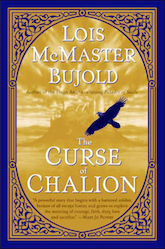

The Curse of Chalion
Bujold’s hero, a washed-up soldier named Cazaril, starts the book not as an atheist, but as a downtrodden, defeated believer: He did trust in the gods, and they failed him. But the plot—and the divine Lady of Spring—swiftly snatch Cazaril up from his (well-earned) depressive state. He finds himself carried along into an adventure that asks everything of him—and takes everything, too.
In the middle of Cazaril’s terrifying journey, someone offers him a metaphor of sainthood by turning a cup upside down and trying to pour wine into it, showing that—with all their power—the gods cannot control a human being without permission. “Men’s will is free,” Caz’s companion says, “The gods may not invade it, any more than I may pour wine into this cup through its bottom.”
The fascinating implication of the inverted wine cup is that while free will matters, your choices are limited: accept the gods’ offer or reject it. And while you control your choice, you don’t control its outcome. Give everything and perhaps you get everything…or maybe you don’t. It’s not up to you. You are not the god or goddess. You are just the poor sap who got caught up in the gears of the adventure. You might get smushed.
Or you might give your life and, in return, find your life again—and find it utterly transformed.
The King of Attolia by Megan Whalen Turner
Buy the Book
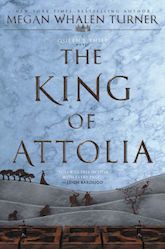

The King of Attolia
Like most of Turner’s Attolia books, this one takes a delightful, sneaky turn mid-story, which means that to discuss the relevant part, I need to give a small spoiler warning. (And here it is: consider yourself warned.)
The delightful secret of this book is that what seems to be a political novel is actually a theological one (though in Turner’s world, the theology and the politics are inexorably intertwined). The real struggle in the novel isn’t between the new king and his (disdainful, possibly rebellious) subjects—no, the real conflict in this story is the incredibly fierce fight that the new king is having with his god. The king is determined that he shall not be a true king, but his god is just as determined that he shall. By choosing a narrator who is not the protagonist, Turner obscures the main players and themes of the story, skillfully dancing and feinting like a trained duelist.
The concepts of free will and inevitability that Bujold is sketching with in Chalion are echoed here, and maybe even expanded—but the most interesting part is how both authors refuse to reject either free will or fate. It seems they must go together for either to mean anything.
The Deed of Paksenarrion by Elizabeth Moon
Buy the Book
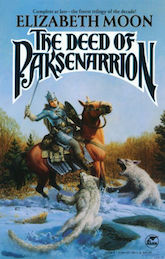

The Deed of Paksenarrion
Paksenarrion’s story is very much a farm-boy-goes-on-the-hero’s-journey story except for one thing: the farm boy is a farm girl. That fact—especially in a story that was first released over a quarter century ago—makes all the difference. Many religious traditions in our own world celebrate both the active and the contemplative paths to holiness. Paksennarion, with her many deeds of valor, definitely gives the reader a chance to ponder what active sanctity might look like.
But the real magic of Moon’s tales (and in this long, winding trilogy, we encounter more stories than just Paks’ own) comes in the way she marries absolute goodness with almost unbearable suffering—I say “almost” only because, even when her saints’ suffering extends all the way to the most wretched deaths, these characters are never forsaken. This is not just death, it is love-unto-death: the love that lays down its life for the beloved, and the beloved that is utterly worth the sacrifice.
Not that it’s always a quid pro quo situation. Some fantasies have a consistent, rules-based magic, and while that kind of precise world-building makes for some very satisfying plots, it takes out an element of the risk. In those stories, you know that if you do X and Y with the magic, then Z will result. Moon’s world, by contrast, has magic, and it matters, but the rules simply aren’t that cut-and-dried. I admit to loving the added nail-biting tension that comes when I, as the reader, am just as unsure about what the gods can and can’t (or will and won’t) do as the protagonist is.
The Bright Smoke, Cold Fire duology by Rosamund Hodge
Buy the Book
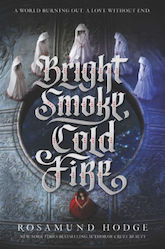

Bright Smoke, Cold Fire
Hodge’s world of Viyara is a bit different from the previous examples in that it might or might not have gods—the various groups of people still alive in the story’s one surviving post-apocalyptic city disagree on the subject of the gods’ reality.Our protagonist, Runajo, doesn’t believe in the gods, but she does believe in the power of blood, and of death, and of sacrifice. She has good reason for her beliefs, too: her city only survives because of the magic wall that surrounds it—a wall that is kept alive through the blood sacrifices of its people.
One of the squickiest, awesomest moments in this story (Hodge is a delight when it comes to combining the grotesquely awful with the beautifully noble) comes when Runajo, as a newly-pledged Sister of the Thorns, must undergo penance. “Penance,” in Viayara, means sitting down and letting the city unwind some of its decorative stonework into long, smooth, rock-tentacles that then plunge themselves into your veins and drink your blood.
It’s a terrible, invasive kind of a sacrifice, and one that feels inherently wrong to Runajo—and, indeed, to anyone who undergoes it. What makes Runajo a heroine to cheer for is that she isn’t satisfied with this kind of sacrifice. If it were enough to save her city, she might be. But, along with her fellow protagonist, Juliet Catresou, Runajo can see clearly that the magic holding up the city’s walls is still failing, and the rest of her adventures are propelled by a keen desire to find the right sacrifice: not something messy and ineffective, but something dire and permanent.
It leads her to places she never expected to go, and into the discovery of relationships—both divine and human—that she never expected to encounter.
The Year of the Warrior by Lars Walker
Buy the Book


The Year of the Warrior
Though Walker’s book is the only one on this list that ostensibly takes place in the real world, it’s a story about a false priest. Aillil is an Irishman taken captive in a raid. To save his skin, he pretends to be a holy father. He lives out the rest of the book in a land far away from his home, carrying out his charade as best he can in a world that suddenly seems charged with the supernatural—for both good and ill.
Aillil is probably the least likable protagonist on this list—he’s certainly the least noble. He is a vice-ridden man, and even though some of the causes of his suffering aren’t his fault, a lot of them are. Yet even though he’s mostly comfortable in his sins, he isn’t allowed to stay the way he is—as he discovers the reality of the supernatural after his capture, his false profession of faith becomes terribly real, and the need for him to be a realpriest in a land filled with demons and worse becomes terribly urgent.
I love this book for its clear insistence that sainthood requires transformation. In order to follow the call, Aillil must change. He can’t stay the man he is: sort of bad, sort of good, mostly selfish and sorrowing. He has to be courageous—worse yet, he has to be charitable. If there is real evil in the world and real good, he has to pick a side, and then he has to let that choice manifest itself and become real in his own self—living it out in his own inclinations and actions and habits.
And that might be the most costly sacrifice of all.
Jessica Snell lives in Los Angeles with her husband and their four children. When Jessica’s not writing or editing, she enjoys knitting, gardening, and traveling up to the mountains whenever she can. You can follow her on Twitter @theJessicaSnell. Her work has appeared in Compelling Science Fiction, Daily Science Fiction, and Tales from Plexis (DAW Books).










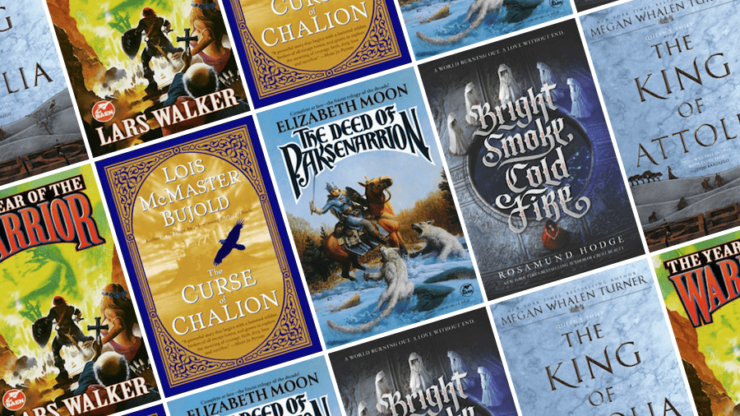
In the sequel to Curse of Chalion, Paladin of Souls, instead of a god trying to pour wine through the bottom of a cup, it’s more like poking a recalcitrant cat with a stick. Complete with hissing and bared fangs.
Lawrence Watt-Evans’ _Touched by the Gods_ would fit here, I think.
The gods are DEFINITELY involved in the world, and their chosen hero didn’t ask for the job.
Another story where the “saint” must give all is in Cusiel’s Dart by Jacqueline Carey. Both the male and female protagonists have a very hard road to ollow for their gods. I made it through the first two books but just couldn’t read the 3rd where the price escalated even higher.
In some stories there is also the idea of be careful what you ask for. What do you do when the gods actually answer and you don’t like what they have to say?
The theme of the article made me chuckle a bit.
As all these authors know, I’m sure, one of the main qualifications for becoming a Christian saint is “die an agonizing death”.
That’s only for martyrs . However saints are expected to be controversial and have enemies. It’s not a requirement but you see it so often the Holy Office expects it.
thinking of Os Venerados in Speaker for the Dead (Orson Scott Card). Sci-fi, not fantasy, but still. The cost to Gusto and Cida was their lives, but the cost to their daughter and grandchildren was far greater.
And of course, Katherine Kurtz ‘s Camber of Culdi
@@@@@ 5, princessroxana
That’s only for martyrs. However saints are expected to be controversial and have enemies. It’s not a requirement but you see it so often the Holy Office expects it.
The original definition of a saint was someone who suffered horrible martyrdom for the faith.
Some magistrate—IIRC in Anatolia—wrote to the Emperor asking what to do with all these irritating Christians. They deliberately broke the law just to be executed. Why couldn’t they just commit suicide privately? Why involve Roman law at all?
Expansionist Christianity had real world saints, typically spreading the word. It also hijacked local Gods and heroes, and turned them into saints. In the same way they hijacked local festivals and holy places. Local celebrations and worship continued unchecked. But the Church took credit for them.
My mind immediately goes to Rand. If there’s ever been a fantasy character that suffered for their theology…
@8 Being dead is still necessary though.
Martyrdom was probably easier to arrange than a lifetime of piety. I think that’s a theme for some of the authors mentioned anyways.
@@@@@ 10, noblehunter
Being dead is still necessary though.
Of course! Dead saints are so much safer. Who knows what a living saint might get up to?
Martyrdom was probably easier to arrange than a lifetime of piety. I think that’s a theme for some of the authors mentioned anyways.
Much easier. Not such an interesting story.
Bujold and Moon both depict challenged, defeated, and saintly characters.
Chalion depicts one of the most interesting spiritual experiences I’ve ever read.
I don’t know other books, and can’t comment.
@8/Fernhunter — You must be thinking of Pliny the Younger’s letter to Trajan, ca. 112 A.D. (And how that “A.D.” would have rankled!) Pliny would order accused Christians to deny Christ and engage in pagan worship. If they refused three times, they would be put to death. However, there is no indication they broke the law “just to be executed”.
After questioning a couple of deaconesses (under torture because they were slaves), Pliny concluded that, aside from their religious non-conformity, Christians were law-abiding. I got the impression he thought persecuting them was a waste of time.
Through a long chain of translations, the story of Siddhartha got Christianized and he became known as St. Josaphat in the Middle Ages. However, this was unusual. Christian missionaries didn’t make saints out of local gods; rather, they provided an appropriate saint to replace, say, the godlet of fish for people to pray to for good luck.
And they let people keep their fun festivals simply by relabeling them — until those killjoy Protestants came along!
@11 Very few protagonists get the easy options.
Caz would probably figure that Christian martyrs got off easy. They only died once.
Plus, in Attolia the king is being forced to change how he acts. He’s been a loner who accomplished things for a long time. The public life of being a king is nothing like how he acts nor had ever wanted to suffer. :[
( “He didn’t marry you to become king. He became king because he wanted to marry you.” )
I like how you characterize the fierce fight. Well done.
Best,
Anne*—
P.S. Fans of Bujold and Miles Vorkosigan would really enjoy Eugenides in the Queen’s Thief series by Megan Whalen Turner.
@@@@@ 12, taras:
You must be thinking of Pliny the Younger’s letter to Trajan, ca. 112 A.D. (And how that “A.D.” would have rankled!) Pliny would order accused Christians to deny Christ and engage in pagan worship. If they refused three times, they would be put to death. However, there is no indication they broke the law “just to be executed”.
After questioning a couple of deaconesses (under torture because they were slaves), Pliny concluded that, aside from their religious non-conformity, Christians were law-abiding. I got the impression he thought persecuting them was a waste of time.
That sounds about right. The last time I was researching this stuff, my only tools were books. Today the details range from fuzzy to gone.
Through a long chain of translations, the story of Siddhartha got Christianized and he became known as St. Josaphat in the Middle Ages. However, this was unusual. Christian missionaries didn’t make saints out of local gods; rather, they provided an appropriate saint to replace, say, the godlet of fish for people to pray to for good luck.
File off the serial numbers, redo the lines, slap on some paint, and you’re good to go.
The Anglo-Saxon Goddess Eostre was all about spring and fertility. Steal her fertility symbols—eggs and bunnies—steal her name for a celebration—and you have Easter.
Odin hung nine days on the world tree Yggdrasill to earn wisdom. Jesus hung on the Holy Rood to redeem the world. A charismatic preacher can use the parallel to slide the White Christ into Nordic consciousness.
The Irish Goddess Brigid gets turned into—the Irish saint Brigid.
You gotta love Jumping Jehosephat.
Early on, before Islam threatened the Eastern Empire, some transmuted Mohamad into Saint Maumat. Later he became a demon.
Icons of an epicene but bearded Christ were turned into Saint Uncumber—patron of bearded ladies and girls wanting to get pregnant.
One Saint got his start as some Latin graffiti on a stone wall. I wish I could remember the details of that one.
And they let people keep their fun festivals simply by relabeling them — until those killjoy Protestants came along!
When it comes to saints, Protestants are 0 for 0. No Romish superstition for them!
Fernhunter @15:
Early on, before Islam threatened the Eastern Empire, some transmuted Mohamad into Saint Maumat.
Do you have a source for that? Most of the earliest Byzantine accounts (e.g., The Teaching of Jacob, written in Palestine in the 630s) portray him as some kind of “false prophet”. (And there wasn’t a whole lot of time “before Islam threatened the Eastern Empire” — the conquest of the Byzantine Levant began in 634, only two years after Muhammad’s death.)
(Maybe you’re thinking of Harry Turtledove’s Agent of Byzantium alternate history, where Muhammad converts to Christianity and becomes a saint, thereby enabling the survival of a strong Byzantine Empire?)
Fernhunter:
The original definition of a saint was someone who suffered horrible martyrdom for the faith.
Well, that idea conflicts with early saints like St. Anne (the mother of the Virgin Mary) and St. Joseph (her husband, who died of old age in the arms of Jesus and Mary). Not to mention the Virgin Mary herself. And St. John the Evangelist is usually said to have died of old age.
So while martrydom was probably the usual path to early sainthood, it wasn’t quite the “definition” thereof.
When it comes to saints, Protestants are 0 for 0. No Romish superstition for them!
Protestant churches do tend to discourage the idea of praying to saints, and make no provision for canonizing new ones, but there is still some residual acknowledgment of classic saints among Anglicans/Episcopalians, Lutherans, and Methodists, for example.
There’s Caliban, the paladin in T. Kingfisher/Ursula Vernon’s Clocktaur Wars duology.
I have not been able to remember or find the author and title of this strange alternate history, in which George Washington becomes a martyr. In fact, I’m not absolutely sure I’m remembering a story, and not a very weird dream.
In the story’s past, Washington fled West after the defeat of the Revolution, and was captured and tortured to death by local warriors. (Ritual cannibalism may have been involved.)
In the story’s present, a couple of generations later, many Native Americans revere him as a sort of Christ figure; their current travails being divine retribution for how he was treated. They worship him by chewing on meat attached to a cross.
@15 — Most historians think St. Brigid of Ireland was a real person. For a Dark Age personage, she is relatively well-documented; better than, say, King Arthur — who was also probably (based on) a real person. That she may have been named after a goddess is not that remarkable; currently Mohammed and Oliver are fighting it out to be the most popular boys’ name in the U.K.
Surprised no-one’s mentioned St. Leibowitz.
My favorite mistaken saint is St. Philomena. In 1802 explorers discovered the grave of a young girl in the Catacomb of Priscilla and interpreted the inscriptions on the tiles closing her grave as indicating she was a martyr named Philomena. St. Philomena’s cult took off like a rocket and she became hugely popular credited with many miracles and a biography based on a nun’s visions.
But the science of archaeology marches on and in the 20th century it became increasingly clear that the young girl lived and died in the 4th c., Long after the persecutions had ended and the tiles closing her grave had been reused from an earlier burial and that the symbols and grave goods thought to indicate martyrdom actually meant nothing of the kind. ”Philomena’ was undoubtedly a practicing Christian buried with the rites of her religion but there’s no reason to believe she possessed heroic virtue and her name certainly was not Philomena. She has been removed from the calendar of saints.
Furthermore — Aillil’s story continues in several sequels by Lars Walker. I imagine he’d be good reading for adolescents, but I think of Walker as sword-and-sorcery for grownups.
@23 — See the world: but only at night. And stay away from Catholic churches.
P.S.: A very clever ploy, vampire hunter!
Jesemin’s the Inheritance Trilogy fits here, I think. How ordinary folks rub against the gods (literally and figuratively) and how that changes both is pretty central to the stories.
Bent my noodle, those books.
The Bahzell Cycle by David Webber is a series I enjoyed. The eponymous protagonist rejects evil and as a consequence creates a series of diplomatic incidents that exile him from his country and send him fleeing across the continent from malevolent forces, all the while rejecting offers of sainthood from the War God because he feels the Gods abandoned them (until the malevolent forces catch up and the only real choice is to become a channel for the War God’s power to save his friend).
@26, The Bahzell series (I wouldn’t call it a Cycle) is fun, but it strikes me as rather superficial, particularly in character. Very plot-driven, and having a tendency to go over-the-top particularly in battle and catastrophe scenes. Indeed it might be said to be to the Challion series what Honor Harrington is to the Miles Vorkosigian series. Longer and with much more info-dumps and technical explanations, but less moving and thoughtful character interaction.
I am not sure that this is invariably true, although it surely is true for most classic fantasy. What then would one call C. J. Cherryh’s The Paladin or David Freedman’s Harald? Not a hint of anything supernatural in either, but most would call them fantasy, and both were so marketed. What about Avram Davidson’t Dr Esterhazy stories. There are various hints there, but little that is clearly supernatural. For the matter of that, what about Bujold’s Sharing Knife series. Ground manipulation seems to be a natural, not a supernatural ability.
I am sure that there are other examples.
@27/David E. Segal- “Cycle” is the word the author uses. YMMV, but I’ve found authors to be more consistent than marketing teams or personal whim on what to call a series.
As to plot-driven verses character-driven, Webber verses Bujold, your mileage obviously varies, but I think you’re doing both authors a disservice. They both have different styles, but I’ve never found the actions of Webber’s characters to conflict with their natures in order to advance the plot, and I equally can’t think of an occasion when Bujold’s character development is meandering. Both authors use the character development to further their plots, and the plots further develop the characters.
You say you find Webber’s character interactions superficial – fair enough, but that’s a subjective judgement and one I don’t agree with. As for info dumps of technical data, Webber’s certainly guilty of that in the Honor Harrington books. They do read like military briefings on Fleet actions, but that’s how they are *supposed* to read. It is a series about naval engagements. The Vorkosigan series has its own info dumps of technical data, but the series has only ever featured one major Fleet engagement “on screen”, so perforce the info dumps are about say, the biology of genetically engineered insect. So both sequences are different animals. Like cats and dogs, they superficially fit the same niche, but people may like both, or just like one but not the other. <shrugs>
But setting aside the suggestion of the Bazhell Cycle’s alleged lack of depth, does anything disqualify him from being in the Fantasy Sainthood collective?
@28/David E. Segal – I respect marketing people for the tough job they do, but they’ve been known to stretch the truth when needed. For my money, if it’s not got a Supernatural element, it shouldn’t be marketed as fantasy, though I see why they would to reach a certain demographic.
As to Ground Sense: it’s a metaphysical ability. There’s nothing natural about something that allows you to gather information without using one of the five senses. As soon as you move beyond sight, sound, smell, taste and touch, I really don’t know how you can call it anything other than supernatural.
Regarding martyrdom, will, death is lighter than a feather, duty heavier than a mountain. It definitely is a trope, and sometimes it is the easy way out. But sometimes it may be the right thing to do.
Also, geez, a saint (in the Catholic term) is litreally just anybody who is in heaven. That’s why we talk about the ‘communion of saints’ and have the feast of ‘All Saints’. A canonized saint is somebody who has been ‘declared’ (ymmv on if you believe that) in Heaven and not in purgatory, but as others have pointed out there is a wide variety of canonized saints including many who died of natural causes and lived more or less normal lives, from all classes and walks of life. Martyrdom is one pathhood to sainthood (and probably the most flashy and talked about) but definitely not the only one. There’s definitely some weird stories from medieval saints of questionable veracity (and of course a bit of a weird focus in certain periods on martyrs/virgins) but there are definitely way more saints than that.
But still, generally the end ‘goal’ for all Catholics is to eventually be a saint.
Sorry, this discussion is making me eye twitchy and pedantic ;)
Catholic saints are a fascinatingly heterogeneous group. Their defining trait is supposed to be heroic virtue, the definition of which has varied over time. They are not expected to be perfect. The Holy Office in fact expects them to be controversial and to make enemies as strong, committed people tend to do.